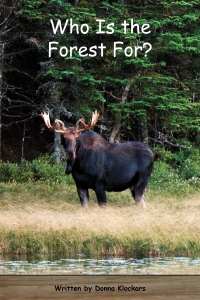by Donna Klockars
A Grandmother and Grandson go for a walk in the forest. The Grandmother encourages her Grandson to watch and listen for an answer to his question, “Who is the forest for?” Illustrations support the tree and forest information in the text.
Strategies/Skills Used
Reading Strategy 1: Access background information.
Reading Strategy 6: Connect what you read with what you already know.
Reading Strategy 7: Determine the most important ideas and events and the relationship between them.
Reading Strategy 8: Extract information from text, charts, graphs, maps and illustrations.
Reading Strategy 11: Make inferences and draw conclusions.
Reading Strategy 12: Reflect and respond.
Writing Skill 2: I organize my ideas based on my purpose for writing.
Writing Skill 5: I carefully choose the most effective words to express my ideas.
 TEACHING THE ACTIVITY: PRE-READING
TEACHING THE ACTIVITY: PRE-READING
 (1) Gather students in a community circle. Present photo images from varying perspectives of coastal trees and forests, and invite students’ background knowledge of this environment through Brainstorming. Ask the question, “When you think of a forest, what comes to your mind?” Record student responses on sticky notes; place on the board.
(1) Gather students in a community circle. Present photo images from varying perspectives of coastal trees and forests, and invite students’ background knowledge of this environment through Brainstorming. Ask the question, “When you think of a forest, what comes to your mind?” Record student responses on sticky notes; place on the board.
(2) Provide an opportunity for students to explore a forested area, to gather and record new thoughts and to add to previously generated ideas.
(3) Introduce a movement break connected to the learning sequence. The yoga “Tree” pose engages students actively in balance, strength and the stillness of trees. Ask students to link arms together to create a group of trees, growing their understanding of the connectedness of a forest. Elicit conversation about that connection.
 TEACHING THE ACTIVITY: DURING READING
TEACHING THE ACTIVITY: DURING READING
(4) Read Who is the Forest For? aloud, inviting responses and posing questions to engage students in conversations about what they are noticing, wondering and inferring from the story. Articulate connections to their pre-reading bank of ideas, ask students for new ideas from the text, and motivate observations of specific tree facts. Notice with students how much information is embedded in the photographs.
(5) Pause on page 14 with the grandson’s realization that the forest is for all of us, and reflect on the grandmother’s response. Pose a question to the students: “What important things can we do to show respect to our forests?”
![]() (6) Set up ahead of time stations around the classroom with large sheets of paper and felt pens. Be prepared with Tree Parts Cards, one for each student. Hand out cards randomly for this cooperative learning strategy, and invite students to create small groups around a sheet of chart paper that include one of each part of a tree. Explain that just as we can join the cards in each group to create a tree, we would like to connect the ideas on our charts to illustrate our one big idea of respect for the forest.
(6) Set up ahead of time stations around the classroom with large sheets of paper and felt pens. Be prepared with Tree Parts Cards, one for each student. Hand out cards randomly for this cooperative learning strategy, and invite students to create small groups around a sheet of chart paper that include one of each part of a tree. Explain that just as we can join the cards in each group to create a tree, we would like to connect the ideas on our charts to illustrate our one big idea of respect for the forest.
(7) Instruct students about the Bubble Thinking activity. Students record single thoughts, in either images or words, in the bubbles – one thought per bubble. After which students can work as a group to connect similar ideas. Let them know that their connections may inspire new thinking and even more thought bubbles.
(8) Have the class do a Gallery Walk to explore and share each other’s ideas.
 TEACHING THE ACTIVITY: POST-READING
TEACHING THE ACTIVITY: POST-READING
(9) Invite students back to a community circle to reflect on their Bubble Thinking experience and reconnect with generated vocabulary about the forest. Reference the Tree Parts Cards and the concept that connected them. Discover, together with students, other relationships between words collected by the class.
(10) Create a Concept Map (sample) by sorting words/ideas by something they have in common.  Draw lines to connect the categories within the sorting rules, write simple sentences on the lines to explain the connections and choose a few areas where students can elaborate their thinking with new ideas from both the story and the class conversation. This can be facilitated as a modeled lesson, a small group project or an individual activity, depending on the learning community.
Draw lines to connect the categories within the sorting rules, write simple sentences on the lines to explain the connections and choose a few areas where students can elaborate their thinking with new ideas from both the story and the class conversation. This can be facilitated as a modeled lesson, a small group project or an individual activity, depending on the learning community.
 TEACHING THE ACTIVITY: POST-READING EXTENSION
TEACHING THE ACTIVITY: POST-READING EXTENSION
(11) Initiate conversations about “respect” using the intergenerational connection between the Grandmother and the Grandson in the story.
(12) Introduce Wild Berries by Julie Flett and Zoe and the Fawn by Catherine Jameson as two other Aboriginal resources that provide students an opportunity to explore the forest more deeply through family relationships and conversations between a child and an elder.
